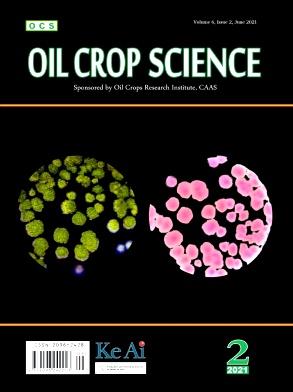Effect of the phytohormone salicylic acid on the salinity thresholds to seed germination and seedling growth in the oilseed Camelina sativa
Q3 Agricultural and Biological Sciences
引用次数: 0
Abstract
The oilseed crop Camelina sativa exhibits salinity tolerance, but the effects on early growth stages across a range of different salts and in combination with salicylic acid (SA) have not been thoroughly evaluated. In this study, seeds were germinated in varying concentrations of six salts (NaCl, CaCl2, ZnCl2, KCl, MgSO4, and Na2SO4) with or without 0.5 mM SA. Using the halotime model, we estimated salt thresholds for germination and parameters of seedling growth. Germination and seedling growth parameters of camelina significantly decreased with increasing salt concentration across all salt types. Salts containing Zn and SO4 were most detrimental to germination and seedling growth. Except for KCl, 0.5 mM SA generally reduced the salinity tolerance threshold (Saltb(50)) of camelina. Specifically, Saltb(50) was 21.5% higher for KCl and 16.1%, 25.0%, 54.9%, 21.0%, and 5.6% lower for CaCl2, NaCl, MgSO4, Na2SO4, and ZnCl2, respectively, when 0.5 mM SA was compared to 0 mM SA. Furthermore, camelina seedling growth was consistently more sensitive than germination across all salt types. SA did not significantly enhance germination or seedling growth and was harmful when combined with certain salts or at the germination stage. It can be concluded that both the type of salt and the concentration of SA are as critical as the salt concentration in saline irrigation water.
植物激素水杨酸对油菜籽种子萌发和幼苗生长盐度阈值的影响
油籽作物Camelina sativa表现出耐盐性,但一系列不同盐以及与水杨酸(SA)组合对早期生长阶段的影响尚未得到全面评估。在这项研究中,种子在不同浓度的六种盐(NaCl, CaCl2, ZnCl2, KCl, MgSO4和Na2SO4)中萌发,有或没有0.5 mM SA。利用halotime模型,我们估计了发芽的盐阈值和幼苗生长的参数。随着盐浓度的增加,亚麻荠种子萌发和幼苗生长参数均显著降低。含Zn和SO4的盐类对种子萌发和幼苗生长最不利。除KCl外,0.5 mM SA普遍降低了亚麻荠的耐盐阈值(Saltb(50))。具体来说,当0.5 mM SA与0 mM SA相比,KCl的Saltb(50)提高了21.5%,CaCl2、NaCl、MgSO4、Na2SO4和ZnCl2的Saltb(50)分别降低了16.1%、25.0%、54.9%、21.0%和5.6%。此外,在所有盐类型中,亚麻荠幼苗生长始终比发芽更敏感。SA对种子萌发和幼苗生长的促进作用不显著,与某些盐类混用或在萌发期对幼苗生长有害。由此可见,盐的种类和SA的浓度与含盐灌溉水的盐浓度一样重要。
本文章由计算机程序翻译,如有差异,请以英文原文为准。
求助全文
约1分钟内获得全文
求助全文
来源期刊

Oil Crop Science
Food Science, Plant Science, Agronomy and Crop Science
CiteScore
3.40
自引率
0.00%
发文量
20
审稿时长
74 days
 求助内容:
求助内容: 应助结果提醒方式:
应助结果提醒方式:


